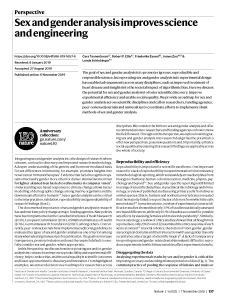Join getAbstract to access the summary!

Join getAbstract to access the summary!
James Zou, Cara Tannenbaum, Londa Schiebinger, Robert P. Ellis and Friederike Eyssel
Sex and Gender Analysis Improves Science and Engineering
Nature, 2019
What's inside?
Integrating sex and gender analysis in scientific research design can lead to important discoveries.
Recommendation
For a long time, gender and sex have played a marginal role in scientific experiments and research, but this is changing. Evidence shows that taking gender and/or sex into account when designing research not only leads to new discoveries and better methodologies, but is often key to coming to the correct conclusions. In this whistle-stop tour through case studies from different disciplines, a group of scientists from various research institutions outline the importance and many benefits of including sex and gender analysis in scientific research.
Summary
About the Authors
Cara Tannenbaum is scientific director of the Institute of Gender and Health, Canadian Institutes of Health Research at the University of Montréal in Canada. Robert P. Ellis is lecturer and NERC Industrial Innovation Fellow in sustainable aquaculture at the College of Life and Environmental Sciences at the University of Exeter in the UK. Friederike Eyssel is professor at the Center of Excellence Cognitive Interaction Technology at Universität Bielefeld in Germany. James Zou is assistant professor of biomedical data science and, by courtesy, of computer science and of electrical engineering at Stanford University, CA in the United States. Londa Schiebinger is the John L. Hinds professor of history of science in the history department and director of the EU/US Gendered Innovations in Science, Health & Medicine, Engineering and Environment Project at Stanford University, CA in the United States.


















Comment on this summary